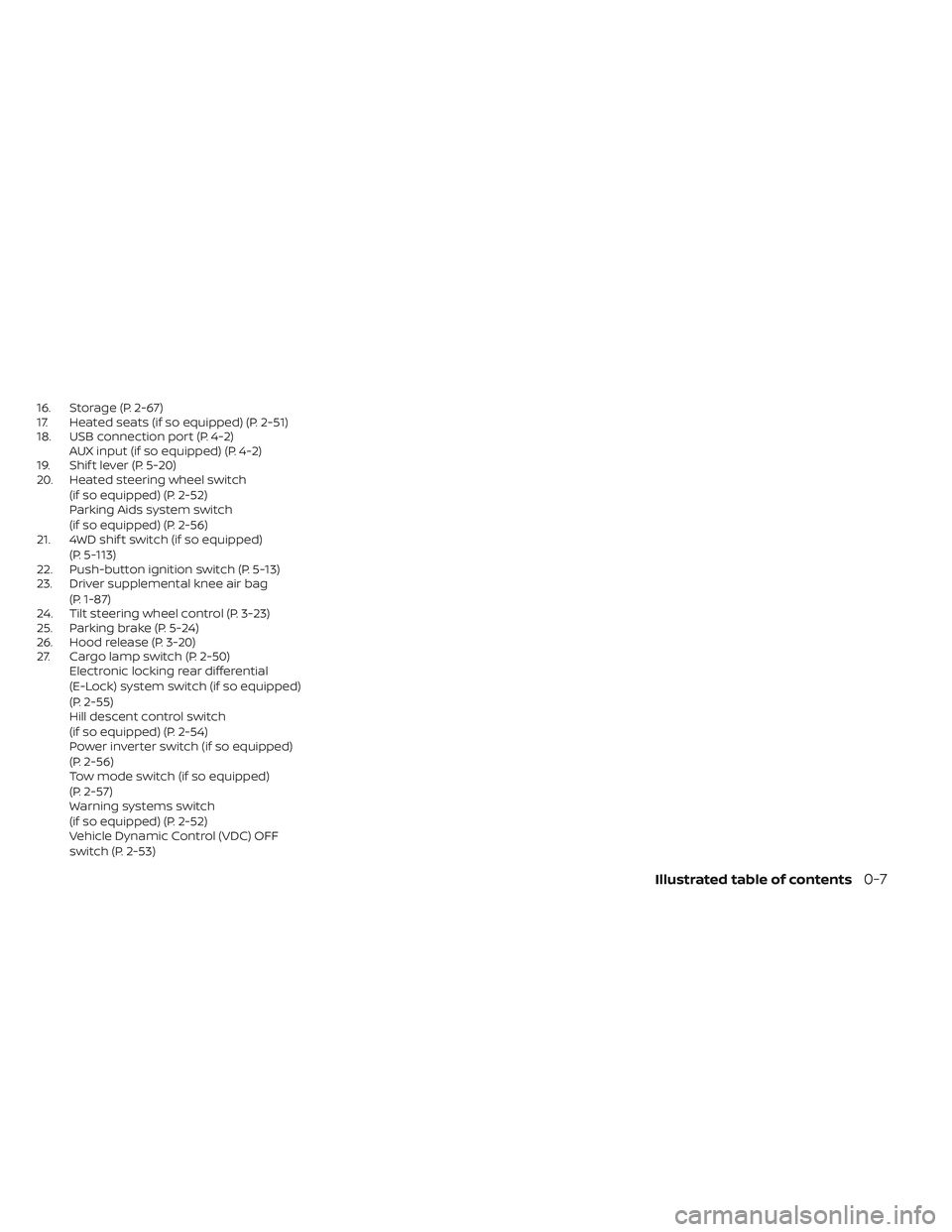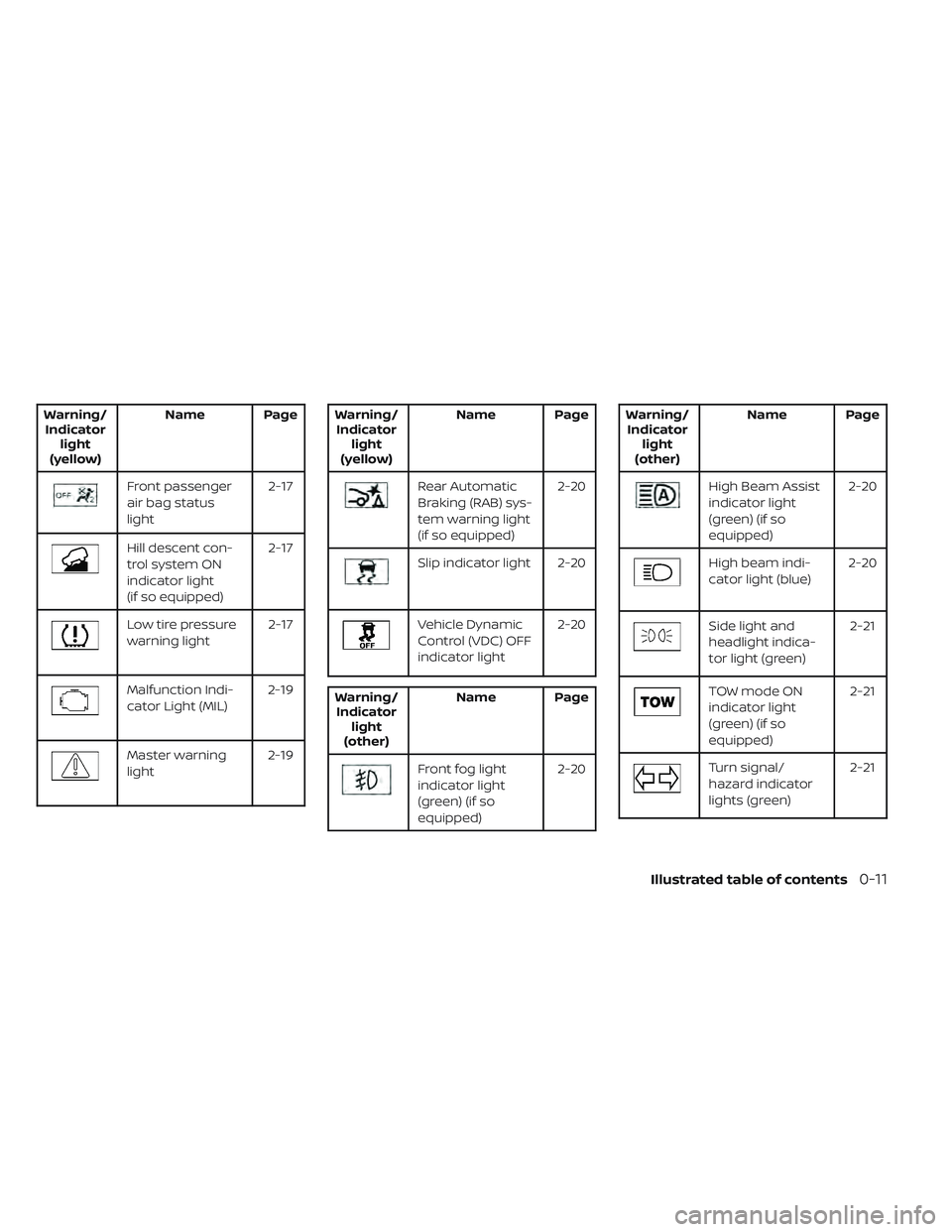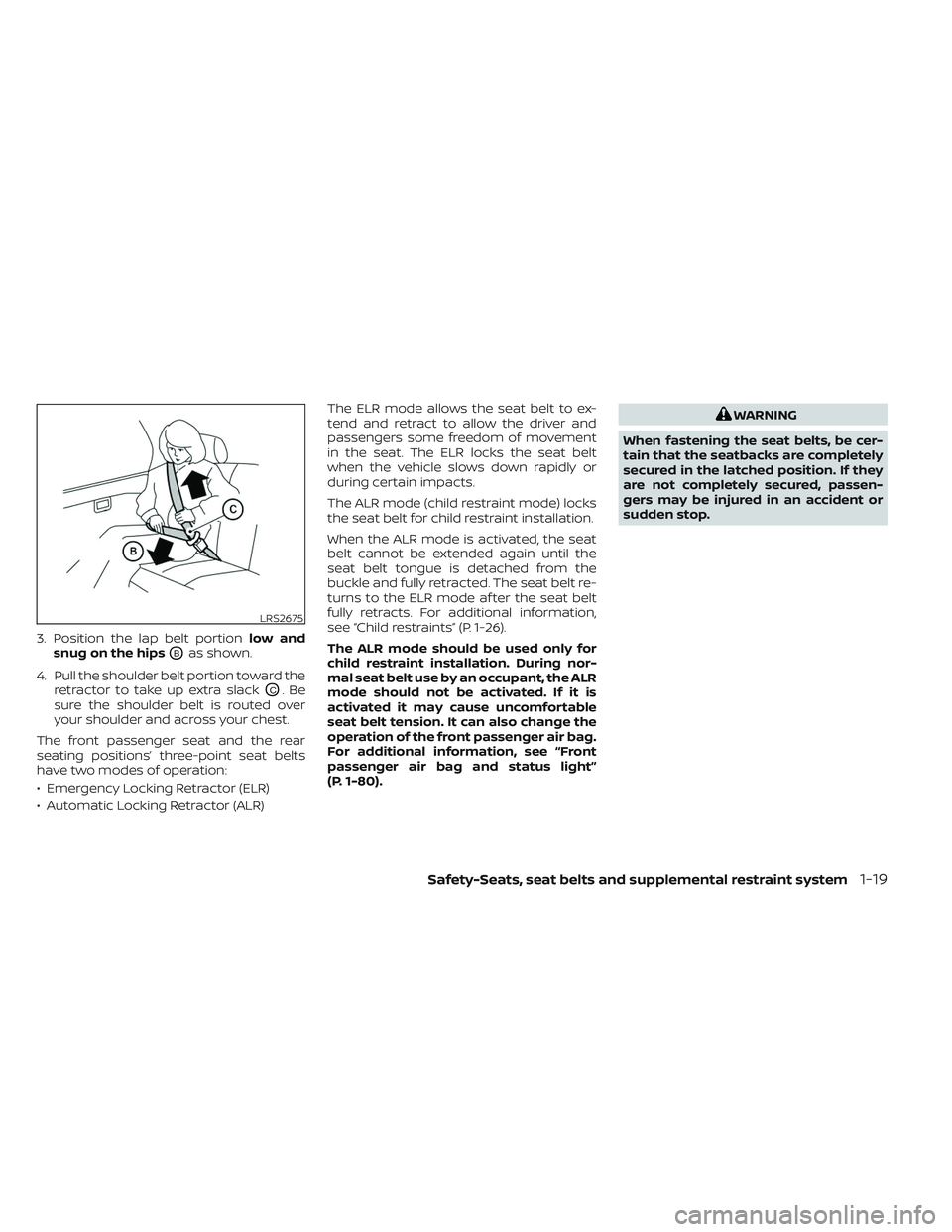2023 NISSAN FRONTIER tow
[x] Cancel search: towPage 14 of 572

1. Rear sliding window (if so equipped)(P. 2-76)
2. Vehicle loading (P. 10-16) Tailgate (P. 3-27)
Truck box (P. 3-27)
3. Towing (if so equipped) (P. 10-27)
4 Rearview camera (P. 4-3, P. 4-11)
5 Rear sonar sensors (if so equipped)
(P. 5-124)
6. Replacing bulbs (P. 8-28)
7. Fuel-filler cap (P. 3-21) Fuel recommendation (P. 10-2)
8. Child safety rear door lock (P. 3-7)
Refer to the page number indicated in
parentheses for operating details.
LII2697
EXTERIOR REAR
0-4Illustrated table of contents
Page 17 of 572

16. Storage (P. 2-67)
17. Heated seats (if so equipped) (P. 2-51)
18. USB connection port (P. 4-2)AUX input (if so equipped) (P. 4-2)
19. Shif t lever (P. 5-20)
20. Heated steering wheel switch
(if so equipped) (P. 2-52)
Parking Aids system switch
(if so equipped) (P. 2-56)
21. 4WD shif t switch (if so equipped)
(P. 5-113)
22. Push-button ignition switch (P. 5-13)
23. Driver supplemental knee air bag
(P. 1-87)
24. Tilt steering wheel control (P. 3-23)
25. Parking brake (P. 5-24)
26. Hood release (P. 3-20)
27. Cargo lamp switch (P. 2-50) Electronic locking rear differential
(E-Lock) system switch (if so equipped)
(P. 2-55)
Hill descent control switch
(if so equipped) (P. 2-54)
Power inverter switch (if so equipped)
(P. 2-56)
Tow mode switch (if so equipped)
(P. 2-57)
Warning systems switch
(if so equipped) (P. 2-52)
Vehicle Dynamic Control (VDC) OFF
switch (P. 2-53)
Illustrated table of contents0-7
Page 21 of 572

Warning/Indicator light
(yellow) Name Page
Front passenger
air bag status
light
2-17
Hill descent con-
trol system ON
indicator light
(if so equipped)2-17
Low tire pressure
warning light
2-17
Malfunction Indi-
cator Light (MIL)2-19
Master warning
light2-19
Warning/
Indicator light
(yellow) Name Page
Rear Automatic
Braking (RAB) sys-
tem warning light
(if so equipped) 2-20
Slip indicator light 2-20
Vehicle Dynamic
Control (VDC) OFF
indicator light
2-20
Warning/
Indicator light
(other) Name Page
Front fog light
indicator light
(green) (if so
equipped) 2-20
Warning/
Indicator light
(other) Name Page
High Beam Assist
indicator light
(green) (if so
equipped) 2-20
High beam indi-
cator light (blue)
2-20
Side light and
headlight indica-
tor light (green) 2-21
TOW mode ON
indicator light
(green) (if so
equipped)2-21
Turn signal/
hazard indicator
lights (green)
2-21
Illustrated table of contents0-11
Page 41 of 572

3. Position the lap belt portionlow and
snug on the hips
OBas shown.
4. Pull the shoulder belt portion toward the retractor to take up extra slack
OC.Be
sure the shoulder belt is routed over
your shoulder and across your chest.
The front passenger seat and the rear
seating positions’ three-point seat belts
have two modes of operation:
• Emergency Locking Retractor (ELR)
• Automatic Locking Retractor (ALR) The ELR mode allows the seat belt to ex-
tend and retract to allow the driver and
passengers some freedom of movement
in the seat. The ELR locks the seat belt
when the vehicle slows down rapidly or
during certain impacts.
The ALR mode (child restraint mode) locks
the seat belt for child restraint installation.
When the ALR mode is activated, the seat
belt cannot be extended again until the
seat belt tongue is detached from the
buckle and fully retracted. The seat belt re-
turns to the ELR mode af ter the seat belt
fully retracts. For additional information,
see “Child restraints” (P. 1-26).
The ALR mode should be used only for
child restraint installation. During nor-
mal seat belt use by an occupant, the ALR
mode should not be activated. If it is
activated it may cause uncomfortable
seat belt tension. It can also change the
operation of the front passenger air bag.
For additional information, see “Front
passenger air bag and status light”
(P. 1-80).
WARNING
When fastening the seat belts, be cer-
tain that the seatbacks are completely
secured in the latched position. If they
are not completely secured, passen-
gers may be injured in an accident or
sudden stop.
LRS2675
Safety-Seats, seat belts and supplemental restraint system1-19
Page 42 of 572

Fastening the seat belts ( jump
seats for King Cab® models)
1. Open the jump seat. For additional infor-mation, see “Seats” (P. 1-2). 2. Slowly pull the seat belt out of the retrac-
tor and insert the tongue into the buckleOAuntil you hear and feel the latch
engage.
•
The retractor is designed to lock dur-
ingasuddenstoporonimpact.A
slow pulling motion permits the seat
belt to move, and allows you some
freedom of movement in the seat.
•If the seat belt cannot be pulled from
its fully retracted position, firmly pull
the belt and release it. Then smoothly
pull the belt out of the retractor.
3. Position the lap belt portion low and
snug on the hips
OBas shown.
4. Pull the shoulder belt portion toward the retractor to take up extra slack
OC.Be
sure the shoulder belt is routed over
your shoulder and across your chest.
The jump seat position's three-point seat
belts have two modes of operation:
• Emergency Locking Retractor (ELR)
• Automatic Locking Retractor (ALR)
LRS0556LRS2723LRS2724
1-20Safety-Seats, seat belts and supplemental restraint system
Page 89 of 572

3. The booster seat should be positionedon the vehicle seat so that it is stable.
If necessary, adjust or remove the head
restraint/headrest to obtain the correct
booster seat fit. If the head restraint/
headrest is removed, store it in a secure
place. Be sure to reinstall the head
restraint/headrest when the booster
seat is removed. For additional infor-
mation, see “Head restraints/headrests”
(P. 1-9). If the seating position does not have an
adjustable head restraint/headrest and
it is interfering with the proper booster
seat fit, try another seating position or a
different booster seat.
4. Position the lap portion of the seat belt low and snug on the child’s hips. Be sure
to follow the booster seat manufactur-
er’s instructions for adjusting the seat
belt routing.
5. Pull the shoulder belt portion of the seat belt toward the retractor to take up ex-
tra slack. Be sure the shoulder belt is
positioned across the top, middle por-
tion of the child’s shoulder. Be sure to
follow the booster seat manufacturer’s
instructions for adjusting the seat belt
routing.
6. Follow the warnings, cautions and in- structions for properly fastening a seat
belt shown in “Three-point type seat belt
with retractor” in this section.
LRS0596
Rear center position
LRS0563
Rear outboard position
Safety-Seats, seat belts and supplemental restraint system1-67
Page 91 of 572

2. Position the booster seat on the seat.Only place it in a front-facing direction.
Always follow the booster seat manu-
facturer’s instructions.
3. The booster seat should be positioned on the vehicle seat so that it is stable.
If necessary, adjust or remove the head
restraint/headrest to obtain the correct
booster seat fit. If the head restraint/
headrest is removed, store it in a secure
place. Be sure to reinstall the head
restraint/headrest when the booster
seat is removed. For additional infor-
mation, see “Head restraint/headrest”
(P. 1-9). If the seating position does not have an
adjustable head restraint/headrest and
it is interfering with the proper booster
seat fit, try another seating position or a
different booster seat.
4. Position the lap portion of the seat belt low and snug on the child’s hips. Be sure
to follow the booster seat manufactur-
er’s instructions for adjusting the seat
belt routing.
5. Pull the shoulder belt portion of the seat belt toward the retractor to take up ex-
tra slack. Be sure the shoulder belt is
positioned across the top, middle por-
tion of the child’s shoulder. Be sure to
follow the booster seat manufacturer’s
instructions for adjusting the seat belt
routing.
6. Follow the warnings, cautions and in- structions for properly fastening a seat
belt shown in “Three-point type seat belt
with retractor” (P. 1-18).
LRS2502LRS0539
Safety-Seats, seat belts and supplemental restraint system1-69
Page 107 of 572

•Do not make unauthorized changes
to your vehicle's electrical system,
suspension system or front end
structure. This could affect proper
operation of the front air bag system.
• Tampering with the front air bag sys-
tem may result in serious personal
injury. Tampering includes changes
to the steering wheel and the instru-
ment panel assembly by placing ma-
terial over the steering wheel pad
and above the instrument panel or
by installing additional trim material
around the air bag system.
• Removing or modif ying the front
passenger seat may affect the func-
tion of the air bag system and result
in serious personal injury. •
Modif ying or tampering with the
front passenger seat may result in
serious personal injury. For example,
do not change the front seats by
placing material on the seat cushion
or by installing additional trim mate-
rial, such as seat covers, on the seat
that are not specifically designed to
assure proper air bag operation. Ad-
ditionally, do not stow any objects
under the front passenger seat or the
seat cushion and seatback. Such ob-
jects may interfere with the proper
operation of the occupant classifica-
tion sensor (weight sensor).
• No unauthorized changes should be
made to any components or wiring
of the seat belt system. This may af-
fect the front air bag system. Tam-
pering with the seat belt system may
result in serious personal injury. •
It is recommended that you visit a
NISSAN dealer for work on and
around the front air bag. It is also rec-
ommended that you visit a NISSAN
dealer for installation of electrical
equipment. The Supplemental Re-
straint System (SRS) wiring har-
nesses* should not be modified or
disconnected. Unauthorized electri-
cal test equipment and probing de-
vices should not be used on the air
bag system.
• A cracked windshield should be re-
placed immediately by a qualified re-
pair facility. A cracked windshield
could affect the function of the
supplemental air bag system.
*
The SRS wiring harness connectors are
yellow and orange for easy identification.
When selling your vehicle, we request that
you inform the buyer about the front air
bag system and guide the buyer to the
appropriate sections in this Owner's
Manual.
Safety-Seats, seat belts and supplemental restraint system1-85